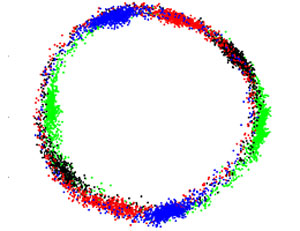| Posted: Jun 30, 2015 |
The secret of the tiny magnetic beads
|
|
(Nanowerk News) They are very small and are used in many biotechnological applications without anybody noticing much of it. Superparamagnetic beads are for example able to track certain substances in liquids or gels, they can mix liquids measuring only a few microliters or filter out individual molecules from solutions. In addition, they enable single-molecule measurements and can be used as sensors and levers on the molecular scale. They can be controlled from the outside by using simple magnets.
|
|
A team of researchers led by Jan Lipfert (LMU Munich) and Nynke Dekker (TU Delft, the Netherlands) has now made these micrometer-sized beads the focus of their research, for, astonishingly enough, the magnetization of these miraculous beads had not been fully understood ("Biological Magnetometry: Torque on Superparamagnetic Beads in Magnetic Fields"). If you understand their magnetic properties, so Jan Lipfert, you can use them to develop new biotechnological applications, and build and improve research tools such as magnetic tweezers.
|
 |
| A micron-sized superparamagnetic bead that is rotated by a bacterial motor in an external magnetic field.
|
|
In their experiments, the international team of researchers used these so-called magnetic tweezers, an instrument where one side of DNA molecules or bacteria such as E. coli, for example, is attached to a glass surface and the other side to the magnetic beads. The researchers then apply external magnetic fields to exert forces directly to the beads and the attached molecules, that is to say, they pull at the molecules or bacteria as if they were using real tweezers. If the magnetic field is in addition rotated, the beads and everything that is connected to them also rotate. “This worked well in practice,” says Lipfert. “But it was not clear why the magnetic field actually rotates the beads. I was astonished myself.”
|
|
Measurement tools at the nanoscale
|
|
There are different models available for explaining this effect. “Originally we thought that these beads have a small ferromagnetic component which causes them to behave like compass needles,” explains Lipfert. The publication of a colleague has proposed such a behavior as a model. “Our measurements, however, show very clearly that such a ferromagnetic model can be ruled out,” declares Lipfert. The researchers pursued the idea that there must be an anisotropy or asymmetry in the magnetization, which means that the tiny paramagnetic nanoparticles are unevenly distributed in the beads. This could explain the observed magnetization and the rotating of the beads.
|
|
With the help of two experiments, the researchers were able to investigate the magnetic anisotropy very exactly. In the first experiment, they attached cells of the bacterium E. coli to the glass surface and attached the magnetic beads to so-called flagellar motors. These motors are normally used by the bacterium to rotate its flagella, lash-like appendages that protrude from the surface of the bacteria. The bacteria use the flagella to propel them and steer them through the human body. It’s similar to swimming in sticky honey, so Lipfert.
|
|
In their experiments, the team led by Jan Lipfert and Nynke Dekker used the flagellar motors to apply a constant torque to the micrometer-sized beads. This is, so to speak, a reversal of their normal application. This way, the biological motors become physical. “In our work, we have used tools from the field of biology to understand a physical problem, that is how superparamagnetic beads behave when rotating in a magnetic field,” explains Lipfert.
|
|
The researchers investigated how an externally applied magnetic field slows down the beads and eventually stalls the molecular motors. This way, Lipfert and his team were able to quantitatively test various models for magnetic anisotropy and rule some out. With this experimental set-up, says Lipfert, the researchers were able to even measure things like the performance or the torque of the motors – at dimensions of approx. 10-20 horse power.
|
|
Enormous potential
|
|
In a second type of experiment, the beads were not actively rotated but attached to the surface via double-stranded DNA molecules. In this set-up, thermal fluctuations caused the beads to rotate. These rotational fluctuations were again measured as a function of the externally applied magnetic field. The results allowed the researchers to quantitatively compare the various models. All together, the measurements ruled out models that proposed a ferromagnetic behavior of the beads similar to that of a compass needle. Instead, they support the theory of an anisotropy of the induced magnetization, either because the beads deviate from an exactly spherical shape or because of an inhomogeneous distribution of the paramagnetic particles in the beads.
|
|
The method can also be used to investigate other molecular motors very exactly. “Our approach has an enormous potential,” explains Lipfert. The results in addition showed that even small beads and relatively modest magnetic fields that are easily generated in the laboratory are sufficient to bring even strong molecular motors, which can rotate bacteria up to one hundred times per second, to a complete standstill and to control them.
|

